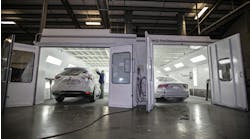Michelin is urging trucking fleets, drivers and owner-operators to follow a steady inspection routine to help ensure tire and wheel-end safety.
“When wheel-off events occur, they can result in damage to property or people, and the main culprit of these events is a lack of a basic, routine maintenance,” says Doug Jones, customer engineering support manager.
“Many fleets and owner-operators have a regular maintenance program that includes checking the tires on their trucks and trailers,” he points out, “but anyone who doesn’t have a program should consider starting one right now.”
The most critical element of any tire maintenance program is maintaining correct tire pressure. Drivers should have an accurate pressure gauge and be instructed to check all the tires, including inner duals, on their truck each day, Jones advises.
Along with tire pressure, another major safety issue that can often be avoided through proper maintenance checks is wheel-offs or runaway wheels, as well as wheel-end fires, which can lead to significant damage or accidents, he says.
During the pre- or post-trip inspection, drivers should inspect the entire wheel end, including the tire, the wheel, the studs and fasteners, the hub area and the brakes. While there are many different methods for tightening wheel fasteners, the most accurate approach has traditionally been the manual torque wrench. Whatever method is selected, notes Jones, the end result on disc wheels must be 450 to 500 foot pounds of torque on each fastener. If a wheel-off does occur and the assembly strikes another vehicle, the resulting impact can be devastating to the driver and any passengers.
In a combined effort with the Tire Industry Association (TIA), Michelin has produced a video available through both organizations that outlines the steps needed to ensure wheel-end safety and help avoid wheel-offs or wheel-end fires.
It shows a controlled test with a standard low-profile truck tire striking a stationary vehicle at about 55 miles per hour. The target is moved almost four inches and the damage to the driver’s door and door jamb is significant. After colliding with the vehicle, the inflated tire finally comes to rest almost 100 feet in the opposite direction.
For more information, visit www.michelin.com and www.tireindustry.org.


